Experimental Study on Strength and Microstructure of Loess Improved by CG-2 Curing Agent and Cement
Abstract
:1. Introduction
2. Materials and Methods
2.1. Materials
2.2. Test Mix Ratio
2.3. Testing Methods
2.3.1. Compaction Test
2.3.2. Unconfined Compressive Strength Test
2.3.3. Triaxial Test
2.3.4. Freeze–Thaw Cycle Test
2.3.5. Dry–Wet Cycle Test
2.3.6. SEM Test
2.3.7. NMR Test
3. Results
3.1. Compaction Test
3.2. UCS Test
3.2.1. Effect of Cement and Curing Agent Content
3.2.2. Effect of Compaction Degree
3.2.3. Effect of Curing Age
3.3. Triaxial Test
3.4. Freeze–Thaw Cycle Test
3.5. Dry–Wet Cycle Test
3.6. Qualitative Analysis of the Microstructure of Modified Loess
3.7. Quantitative Analysis of Curing Agent Content on the Microstructure of Improved Loess
4. Discussion
5. Conclusions
- (1)
- Cement and curing agent are the main factors affecting the strength and stability of the improved loess. Increasing the content of curing agent and cement can significantly enhance the unconfined compressive strength of the improved loess. And, under the same strength conditions, the incorporation of curing agent can effectively reduce the amount of cement. The incorporation of curing agent and cement will also increase the peak strength and residual strength of the stress–strain curve of the improved loess.
- (2)
- Curing agent and cement can significantly improve the freeze–thaw resistance and dry–wet cycle resistance of the improved loess. Compaction and curing age are also convenient and effective means of improving the strength of the improved loess.
- (3)
- Considering the economic benefit and the strength index of the engineering application, the optimum mixing ratio of cement and curing agent is 6% and 0.020%. The compaction degree is at least 94%, and the curing age is at least 14 days.
- (4)
- In the qualitative and quantitative analysis of the microstructure of the improved loess, it was found that the reaction products of the curing agent and cement with the loess will wrap and agglomerate the soil particles, and its unit form develops from single particle to aggregate and agglomerate. These aggregates further fill the skeleton of soil particles, and their connection mode develops from a large number of point contacts to surface contacts, which eventually changes the arrangement of soil particles from the dominance of large pores and overhead pores to the dominance of intergranular pores, so the strength and stability of the soil are greatly improved.
Author Contributions
Funding
Data Availability Statement
Conflicts of Interest
References
- Xie, D.Y. Some new trends in the research of loess mechanics in China. J. Geotech. Eng. 2001, 1, 3–13. [Google Scholar]
- Gao, G.R. Classification of loess microstructure and wetting. Chin. Sci. 1980, 12, 1203–1208+1237–1240. [Google Scholar]
- Lei, X.Y. Pore types and wet subsidence of loess in China. Chin. Sci. 1987, 12, 1309–1318. [Google Scholar]
- Li, P.; Xie, W.; Pak, R.Y.; Vanapalli, S.K. Microstructural evolution of loess soils from the Loess Plateau of China. CATENA 2018, 173, 276–288. [Google Scholar] [CrossRef]
- Liang, Z.C.; Zhang, A.J.; Ren, W.Y.; Wang, Y.G.; Hu, J.F.; Han, J.W. Fitting model and microscopic properties of soil-water characteristics of lime-amended loess. J. Geotech. Eng. 2022, 44, 241–246. [Google Scholar]
- Gao, M.N.; Wang, X.; Li, J.D.; Zhang, Y.J.; Jiang, D.J. Experimental study on strength and microstructure of bentonite lime-amended loess. J. Water Resour. Water Transp. Eng. 2022, 5, 86–93. [Google Scholar]
- Qi, X.Q.; Yuan, K.J.; Cai, L.Y.; Liu, H.P.; Dong, X. Study on factors affecting the scour resistance of cement-amended loess. Silic. Bull. 2021, 40, 2418–2427. [Google Scholar]
- Yan, A.J. Experimental study on cement improvement of loess-like soil. J. Water Resour. Water Eng. 2015, 26, 225–228. [Google Scholar]
- Zhang, L.P.; Zhang, X.C.; Sun, Q. Engineering characteristics of loess reinforced with EN-1 curing agent and its influencing factors. China Soil Water Conserv. Sci. 2009, 7, 60–65. [Google Scholar]
- Zhang, L.J.; Li, Y.; Liu, H.H. Experimental study on reinforcing loess with composite BTS curing agent. Roadbed Eng. 2016, 6, 125–128. [Google Scholar]
- Zhang, H.Y.; Lin, C.B.; Sheng, Y.M. Experimental study on the engineering properties of loess modified by anti-sparging force hardener. J. Rock Mech. Eng. 2015, 34, 3574–3580. [Google Scholar]
- Wang, Y.M.; Xu, P.F. Scour resistance test of new polymer material curing loess slope. Chin. J. Geol. Hazards Prev. 2018, 29, 92–96. [Google Scholar]
- Wang, L.P.; Han, L.X.; Zhu, Y.H.; Liu, F.Y. Research on the microfabrication characteristics and modification mechanism of loess modified by anti-hydrophobicity curing agent. J. Xi’an Univ. Technol. 2023, 39, 423–432. [Google Scholar]
- Wu, W.F.; Zhang, J.Y.; He, R.; Chen, H.X. Study on strength and water stability of cement-stabilized loess improved by curing agent. Silic. Bull. 2016, 35, 2159–2165. [Google Scholar]
- Liu, Y.M.; Zhang, X.C. Effects of EN-1 ionic curing agent on water holding and water supply and other water characteristics of loessy soil. Soil Bull. 2014, 45, 24–31. [Google Scholar]
- Amin, Z.; Mehdi, S.; Hamed, R. Effect of lime-rice husk ash on geotechnical properties of loess soil in Golestan province, Iran. Int. J. Geo-Eng. 2023, 14, 20. [Google Scholar]
- Jiang, Y.J.; Ni, C.Y.; Sha, H.W.; Li, Z.H.; Cai, L.Y. Deterioration characteristics of cement-improved loess under dry-wet and freeze-thaw cycles. PLoS ONE 2021, 16, e0253199. [Google Scholar] [CrossRef]
- Zhang, B.; Jiang, W.; Xu, Q.; Yuan, D.; Shan, J.; Lu, R. Experimental feasibility study of ethylene-vinyl acetate copolymer (EVA) as cement stabilized soil curing agent. Road Mater. Pavement Des. 2020, 23, 617–638. [Google Scholar] [CrossRef]
- Collins, K. A Scanning Electron Microscopy Study of Natural Engineering Soil. Ph.D. Thesis, University of Strathclyde, Glasgow, Scotland, 1978. [Google Scholar] [CrossRef]
- Kenyon, W.E. Nuclear magnetic resonance as a petrophysical measurement. The International journal of radiation applications and instrumentation. Part E. Nucl. Geophys. 1992, 6, 153–171. [Google Scholar]
- Wang, L.; Cheng, W.-C.; Xue, Z.-F. Investigating microscale structural characteristics and resultant macroscale mechanical properties of loess exposed to alkaline and saline environments. Bull. Eng. Geol. Environ. 2022, 81, 146. [Google Scholar] [CrossRef]
- Liu, C.; Shi, B.; Zhou, J.; Tang, C. Quantification and characterization of microporosity by image processing, geometric measurement and statistical methods: Application on SEM images of clay materials. Appl. Clay Sci. 2011, 54, 97–106. [Google Scholar] [CrossRef]
- Ministry of Transportation, People’s Republic of China. Test Methods of Materials Stabilized with Inorganic Binders for Highway Engineering: JTG-E51-2009 [S]; People’s Transportation Press: Beijing, China, 2009.
- Bai, Y.; Ye, W.; Wu, Y.; Chen, Y. Multiscale analysis of the strength deterioration of loess under the action of drying and wetting cycles. Adv. Mater. Sci. Eng. 2021, 2021, 6654815. [Google Scholar] [CrossRef]
- Xu, J.; Li, Y.; Ren, C.; Lan, W. Damage of saline intact loess after dry-wet and its interpretation based on SEM and NMR. Soils Found. 2020, 60, 911–928. [Google Scholar] [CrossRef]
- Liu, J.; Xu, Q.; Li, P.; Pu, C.; Zhao, K.; Peng, D.; Lei, M. Determination of nuclear magnetic resonance T2 cutoff in remoulded loess by the freezing point. Eur. J. Soil Sci. 2023, 74, e13406. [Google Scholar] [CrossRef]
- Coates, G.R.; Xiao, L.L.; Prammer, M.G. NMR Logging Principles and Application; Halliburton Energy Services Publication: Houston, TX, USA, 1999. [Google Scholar]
- Li, J.D.; Wang, X.; Zhang, Y.J.; Jiang, D.J.; Liu, D.R.; Ma, X.N.; Wang, J.L. Experimental study on strength and microstructure of loess reinforced with F1 ionic soil stabilizer. J. Southeast Univ. 2021, 51, 7. [Google Scholar]
- Moore, C.A.; Donaldson, C.F. Quantifying soil microstructure using fractals. Geotechnique 1995, 45, 105–116. [Google Scholar] [CrossRef]
- Xue, C.; Wang, X.; Lian, B.; Luo, L.; Liu, K. Research on the mechanism of composite improvement of loess based on quantitative analysis of microstructure and mechanical strength. Constr. Build. Mater. 2023, 379, 131215. [Google Scholar] [CrossRef]

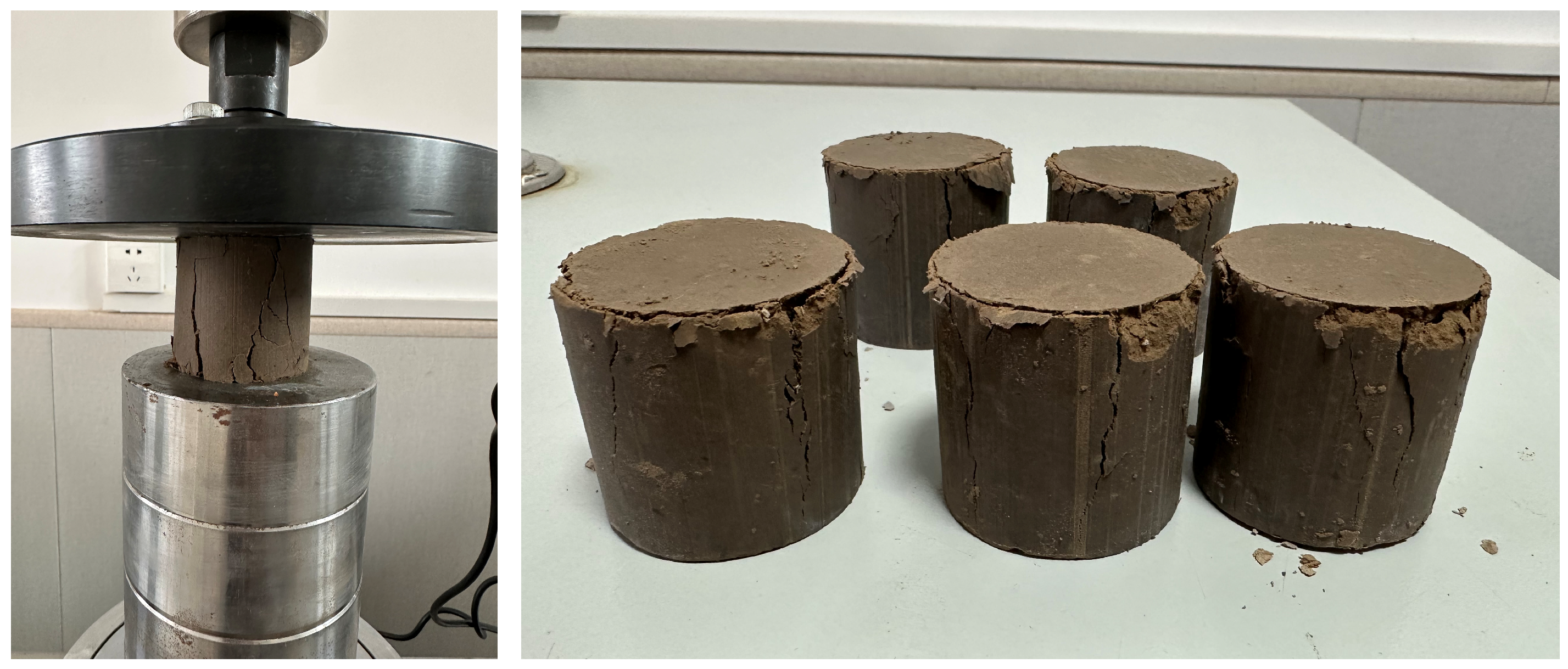
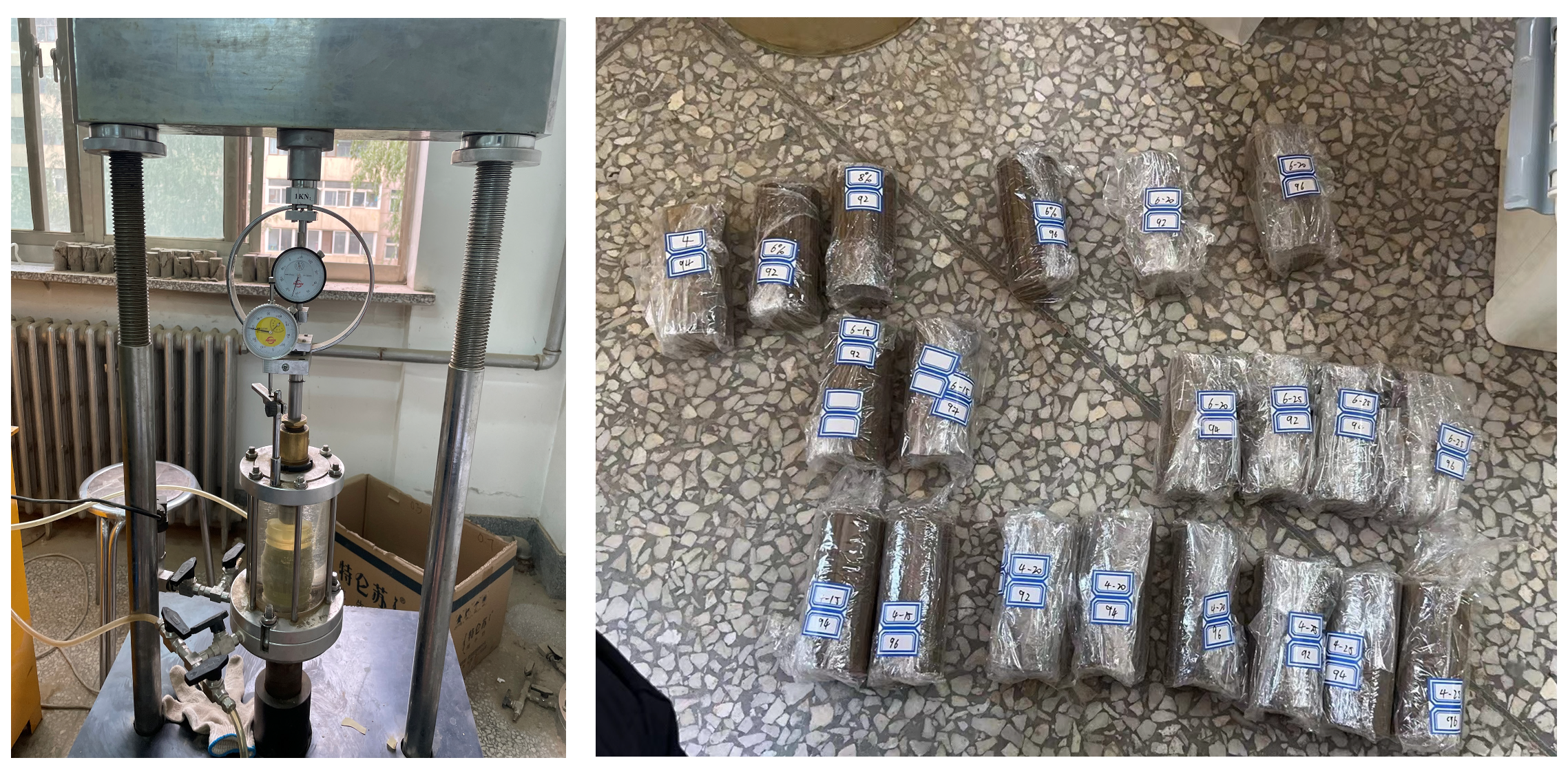

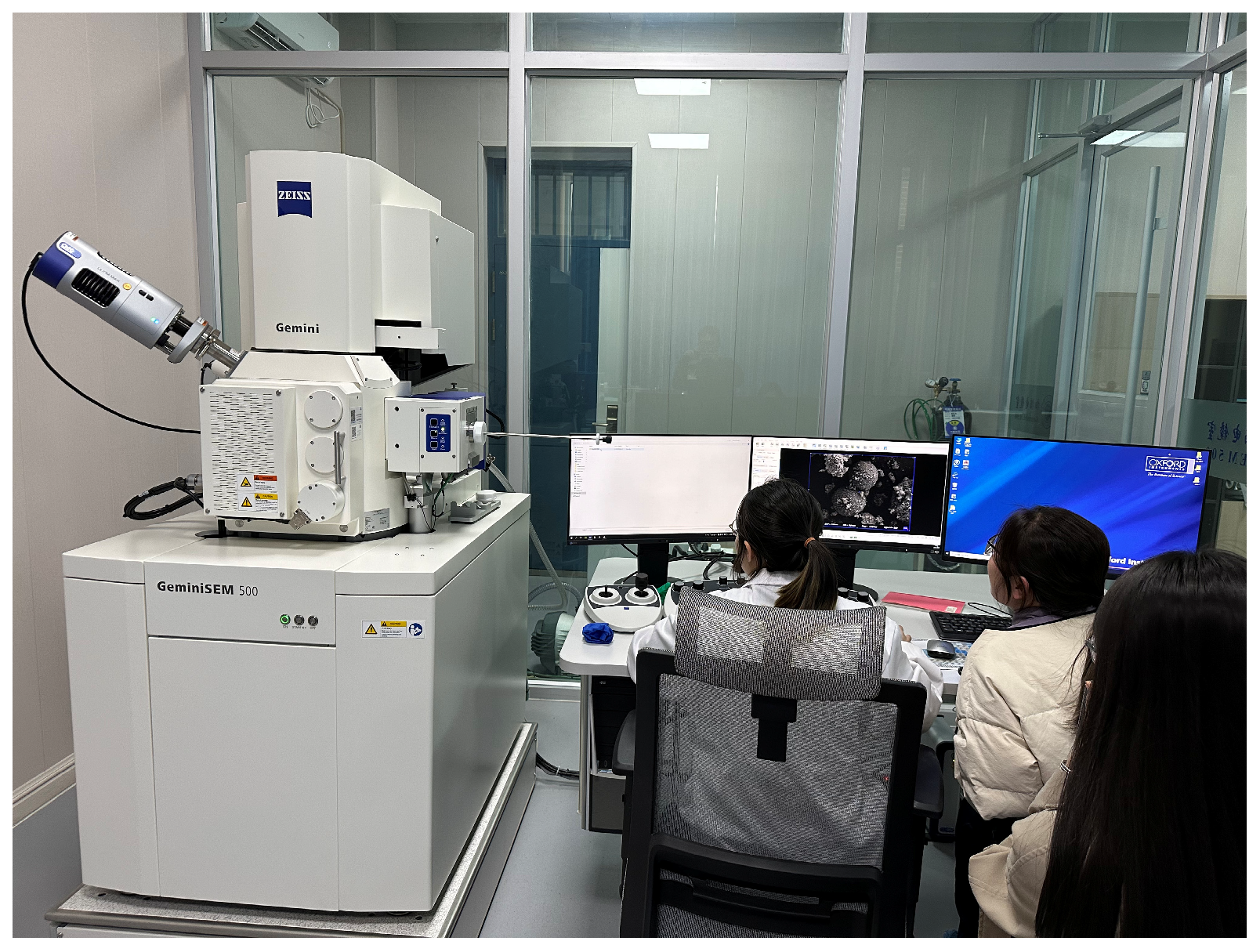

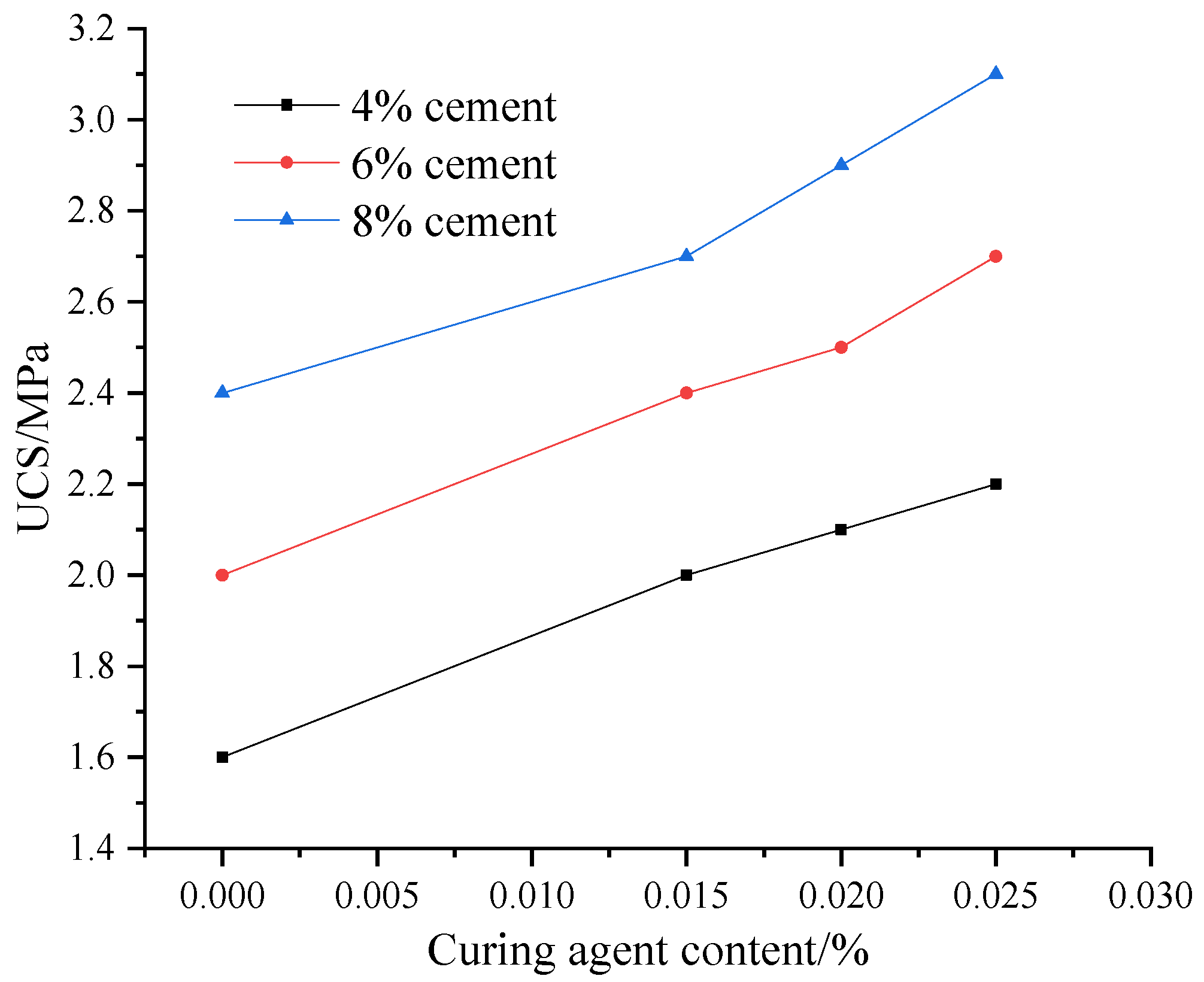
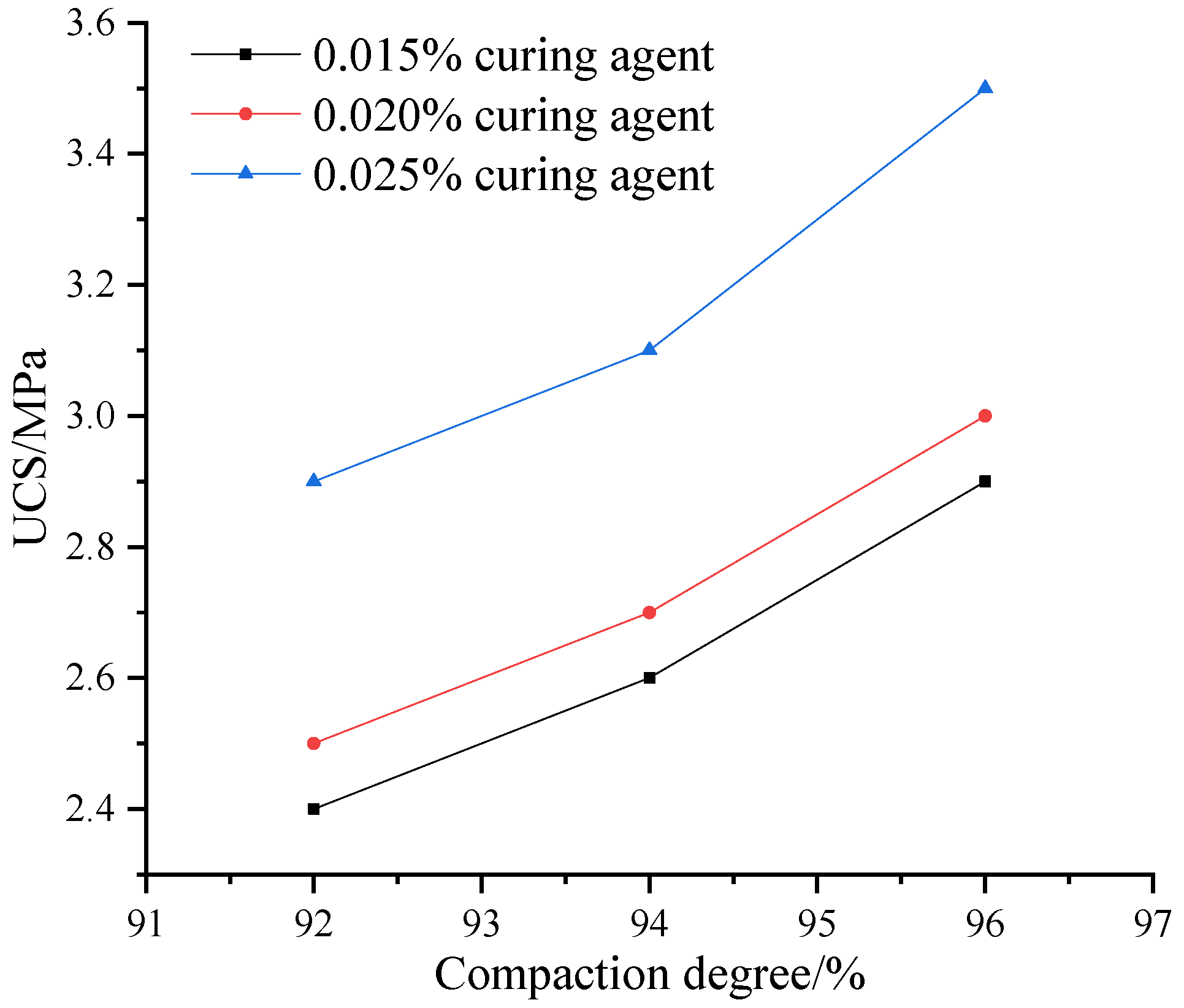
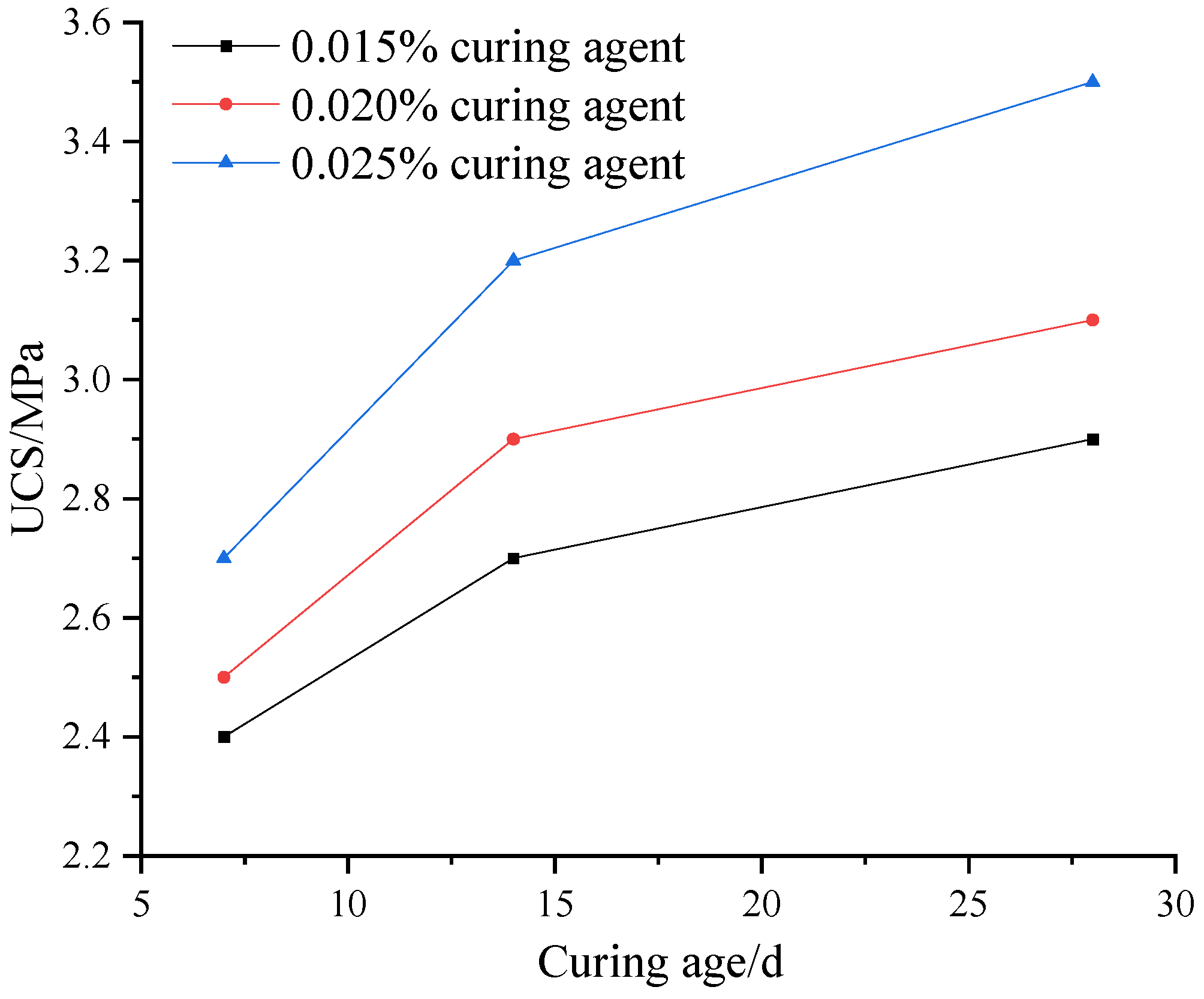
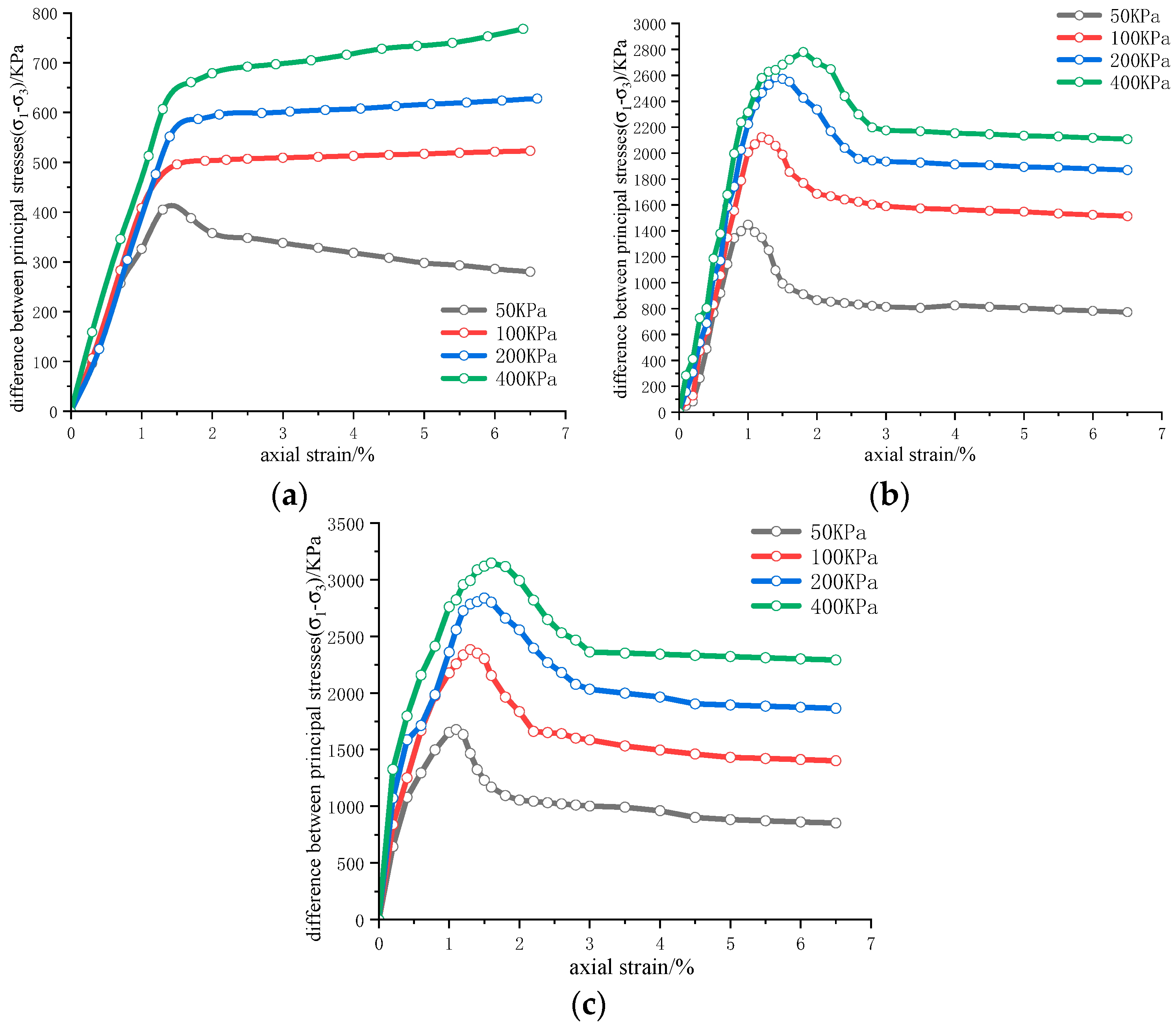
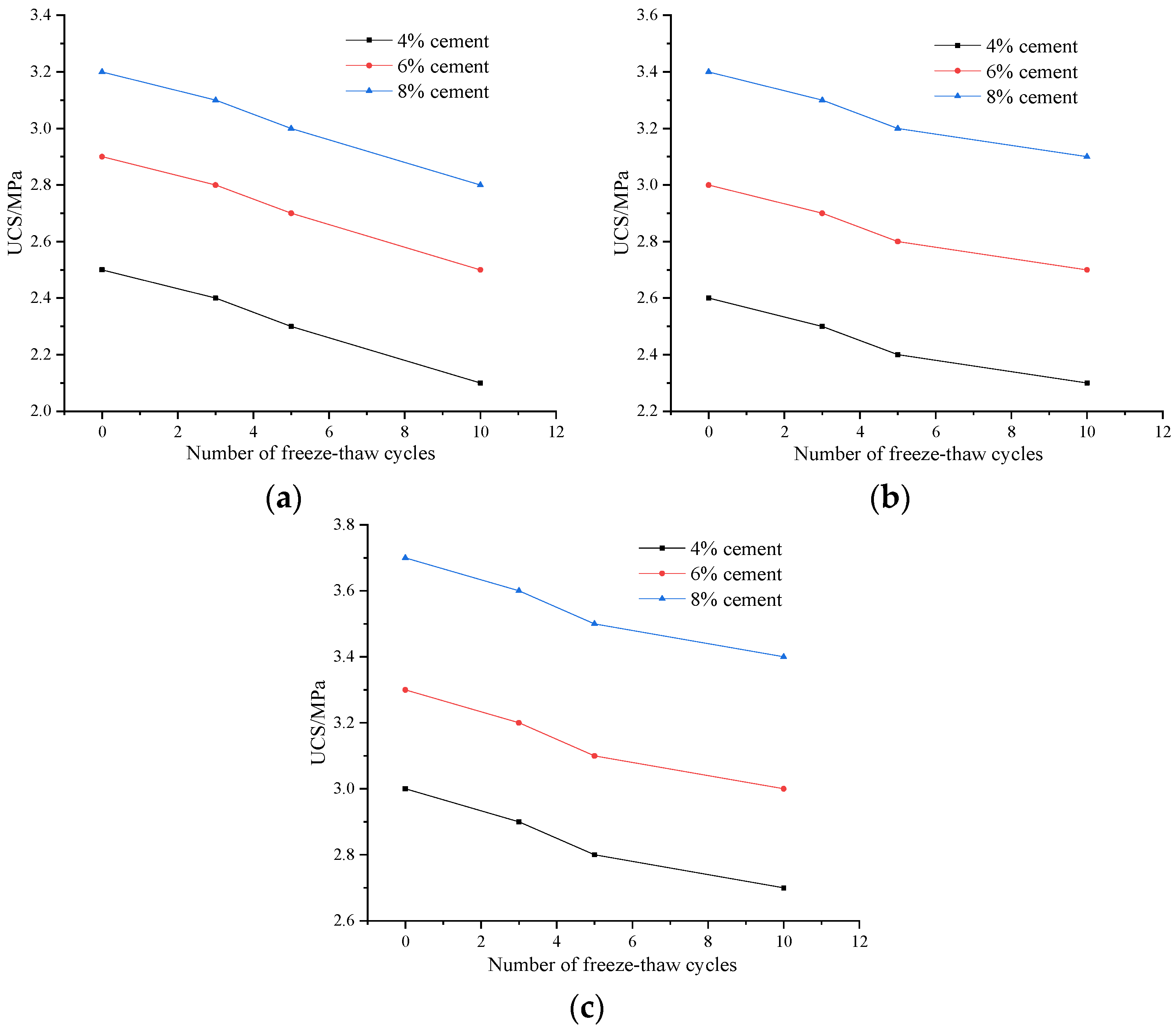

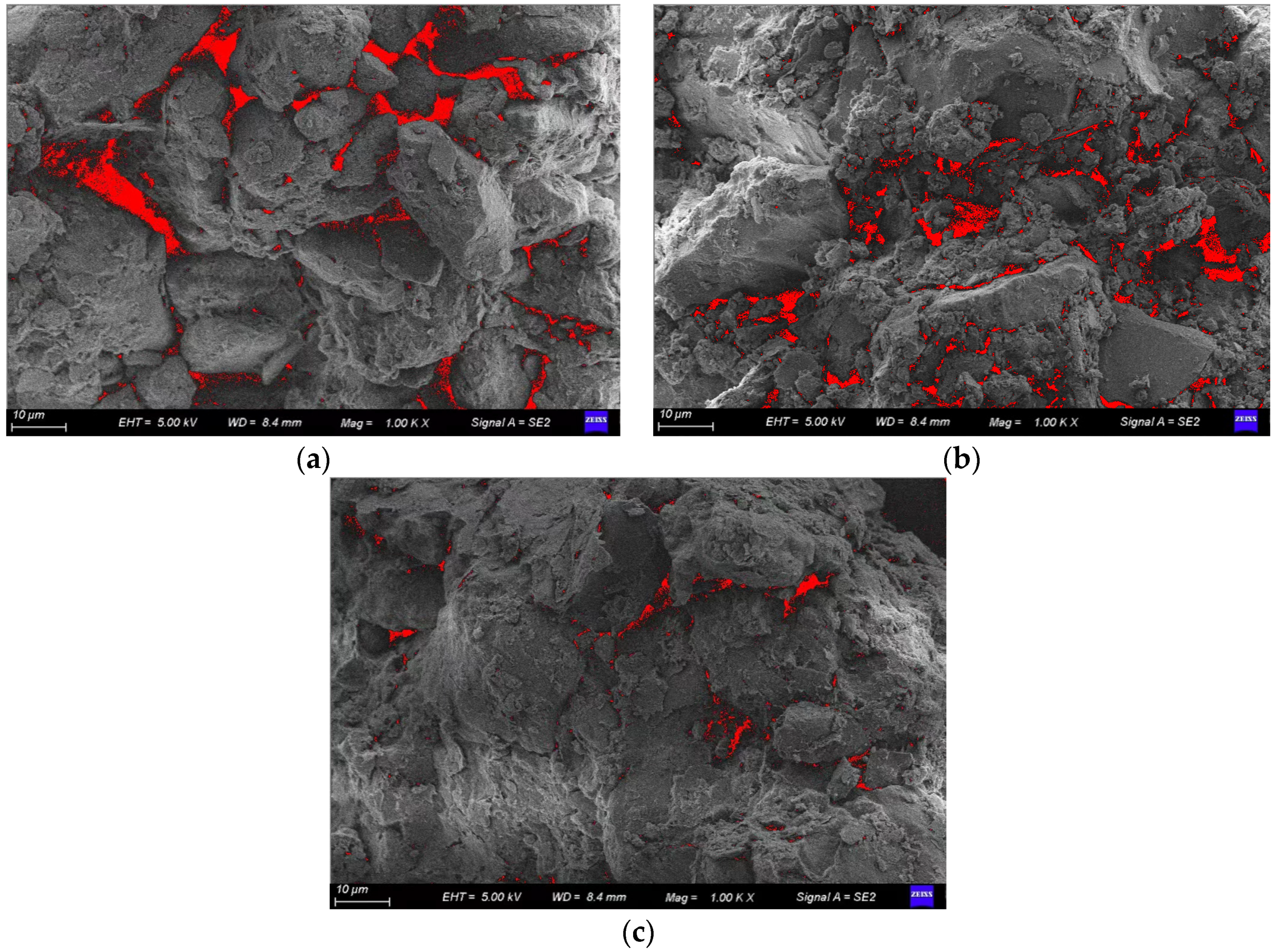
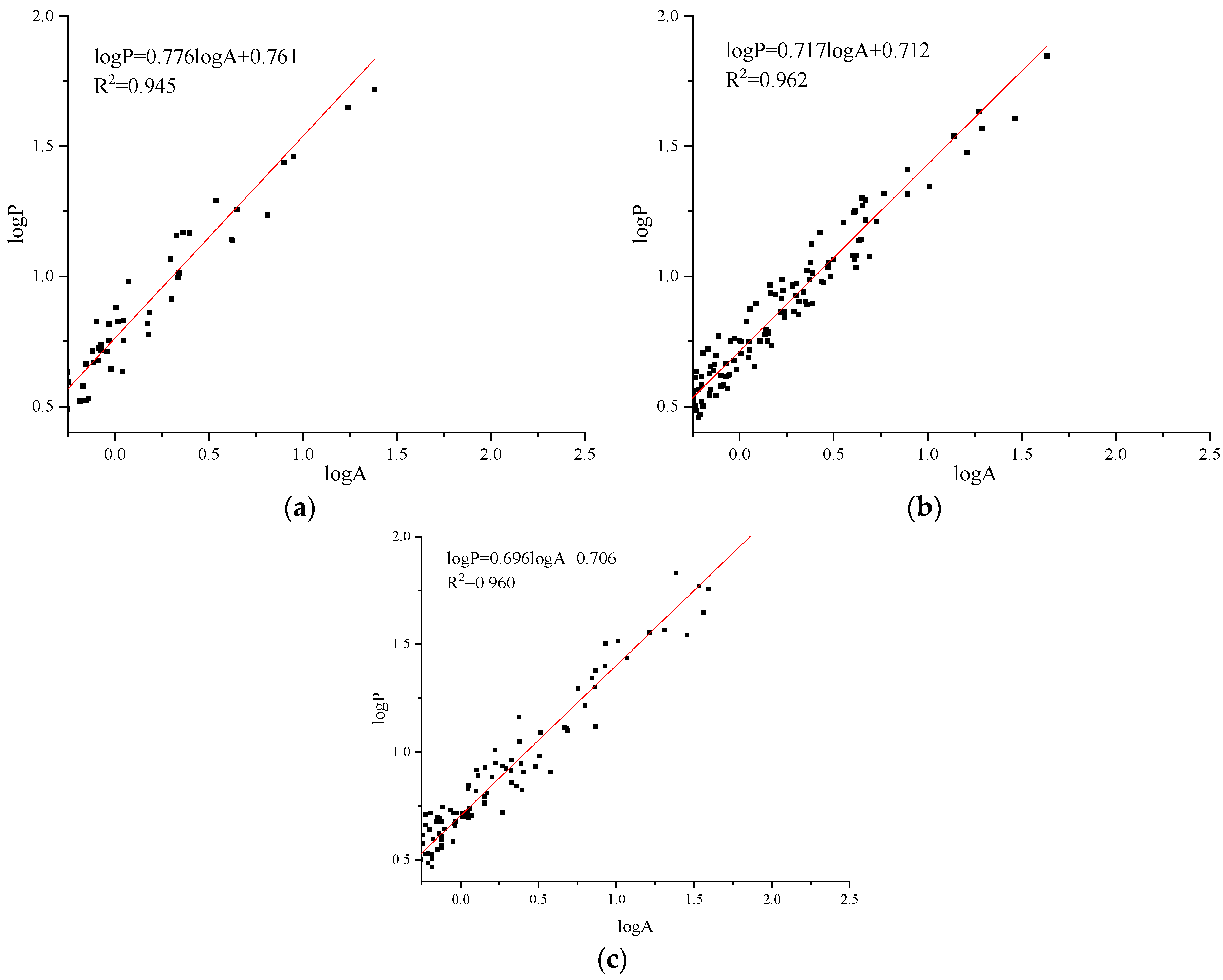

| Liquid Limit WL/% | Plastic Limit WP/% | Optimum Moisture Content/% | Maximum Dry Density/g·cm−3 | Particle Size Distribution/% | |||||
|---|---|---|---|---|---|---|---|---|---|
| <0.005 | 0.005–0.05 | 0.05–0.075 | 0.075–0.1 | 0.1–0.25 | >0.25 | ||||
| 28.8 | 18.2 | 12.1 | 1.88 | 9.28 | 63.11 | 18.02 | 6.56 | 3.03 | 0 |
| Break Off Strength/MPa | Compressive Strength/MPa | Setting Time/min | Specific Surface Area (m2/kg) | |||
|---|---|---|---|---|---|---|
| 3 d | 28 d | 3 d | 28 d | initial set | final set | 338 |
| 4.8 | 8.6 | 24.6 | 44.3 | 205 | 255 | |
| Dosage of Curing Agent /% | Cement Content /% | Optimum Moisture Content /% | Maximum Dry Density /g·cm−3 |
|---|---|---|---|
| 0 | 4 | 12.85 | 1.93 |
| 6 | 13.35 | 1.98 | |
| 8 | 12.85 | 1.91 | |
| 0.015 | 4 | 12.25 | 1.90 |
| 6 | 12.55 | 1.91 | |
| 8 | 12.41 | 1.89 | |
| 0.020 | 4 | 12.62 | 1.91 |
| 6 | 12.78 | 1.93 | |
| 8 | 12.50 | 1.90 | |
| 0.025 | 4 | 12.35 | 1.90 |
| 6 | 12.55 | 1.91 | |
| 8 | 12.40 | 1.86 |
| Number of Wet and Dry Cycles | Without Curing Agent | 0.020% Curing Agent Content | ||||
|---|---|---|---|---|---|---|
| Cement Content | CEMENT Content | |||||
| 4% | 6% | 8% | 4% | 6% | 8% | |
| 0 | 1.6 | 2.1 | 2.5 | 2.1 | 2.5 | 2.9 |
| 3 | 1.2 | 1.8 | 2.2 | 1.8 | 2.3 | 2.7 |
| 5 | 0.9 | 1.6 | 2.0 | 1.6 | 2.1 | 2.5 |
Disclaimer/Publisher’s Note: The statements, opinions and data contained in all publications are solely those of the individual author(s) and contributor(s) and not of MDPI and/or the editor(s). MDPI and/or the editor(s) disclaim responsibility for any injury to people or property resulting from any ideas, methods, instructions or products referred to in the content. |
© 2024 by the authors. Licensee MDPI, Basel, Switzerland. This article is an open access article distributed under the terms and conditions of the Creative Commons Attribution (CC BY) license (https://creativecommons.org/licenses/by/4.0/).
Share and Cite
Ma, X.; Liu, Y.; Yin, W.; Wang, X.; Guo, S. Experimental Study on Strength and Microstructure of Loess Improved by CG-2 Curing Agent and Cement. Buildings 2024, 14, 877. https://doi.org/10.3390/buildings14040877
Ma X, Liu Y, Yin W, Wang X, Guo S. Experimental Study on Strength and Microstructure of Loess Improved by CG-2 Curing Agent and Cement. Buildings. 2024; 14(4):877. https://doi.org/10.3390/buildings14040877
Chicago/Turabian StyleMa, Xuening, Yuhang Liu, Wenhua Yin, Xiaodong Wang, and Shulin Guo. 2024. "Experimental Study on Strength and Microstructure of Loess Improved by CG-2 Curing Agent and Cement" Buildings 14, no. 4: 877. https://doi.org/10.3390/buildings14040877





